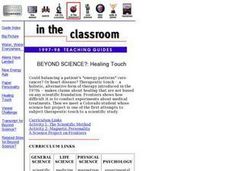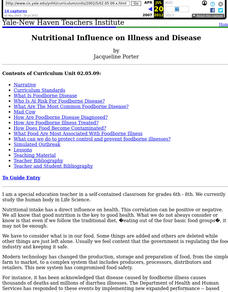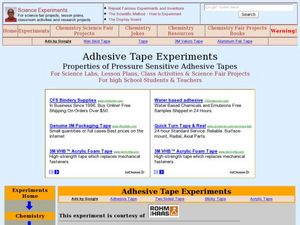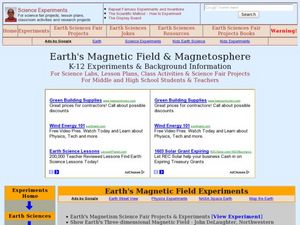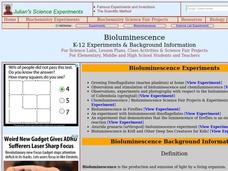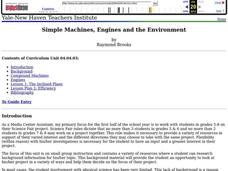US Department of Energy
Geothermal Energy
With Earth Day quickly approaching, as well as many science fairs, why not challenge your class to investigate geothermal energy or other renewable energy resources? There are five driving questions explored in depth here, as well as...
Curated OER
Quality of Life Investigations: Risk Reductions
Middle schoolers participate in a discussion of recent environmental issues affecting their own community or ones nearby. In groups, they research the role of food additives and the purpose of adding them to foods. They also determine...
Curated OER
Organic Farming / Agriculture
Want an organic farming resource packed with experiments, background information, science fair projects, and topics of interest for further research? Here it is. Young environmental scientists can explore concepts involved in organic...
Curated OER
Classroom Science Fair Project
Students explore the skills and information needed to complete a science fair project. They follow guidelines to create an document their science fair project.
Curated OER
Designing the Perfect Science Fair Project Webquest
Sixth graders examine the Scientific Method and define their topic of interest. Students familiarize themselves with how to utilize their resources and create note cards. Students create their written report and display of their...
Curated OER
Energy Efficiency Ambassadors
Students research energy conservation devices. They also create their own light efficiency project and presents their findings on science fair night.
Curated OER
Beyond Science?: Healing Touch
Students apply the scientific method by building a "Proposal for Study." They label the Observation, Hypothesis, and Prediction columns. Students listen as the teacher introduces the alternative healing methods of therapeutic touch and...
Curated OER
Nutritional Influence on Illness and Disease
Students examine nutritionally related diseases and illnesses, evaluating studies and developing topics for a science fair project. They investigate bacteria, researching how it can be harmful or helpful, and create illustrated displays.
Curated OER
Water Cycle
High schoolers identify the different stages in the water cycle. In this earth science lesson, students calculate the residence time of water in oceans using a mathematical formula. They explain how this cycle regulates the Earth's climate.
Curated OER
"Stick to It!" Properties of Pressure Sensitive Adhesive Tapes
Students investigate the strength of different adhesives. In this physical science lesson plan, students compare the force needed to peel adhesive tapes from a surface. They analyze collected data and make a generalization.
Curated OER
Biology Biographies
Students create a project about a famous Biologist in order to appreciate the humanity of the people involved in doing science. They create scientist biography "cards" roughly modeled after baseball cards or create a scrapbook of a...
Curated OER
What Does Life Look Like Under a Microscope?
Young scholars discover cells make up all living things. In this life science lesson plan, students investigate living organisms and the cells that create them. Finally the young scholars create a testable question, conduct an...
Curated OER
Genetically Modified Food (GMF)
Explore genetically modified foods through various experiments. For this biology lesson, students discuss the safety issues related to GMF's. They conduct a PCR analysis to identify the presence of genetic modification.
Curated OER
Wonderfully Wild Unit
Students explore the ethics of 'fair' in regards to humans relationship with wildlife. For this wildlife study lesson, students read the story starters about wildlife and then discuss how to finish the story. Students finish the stories...
Curated OER
Plan a Mission to Recently Discovered Planet
Pupils plan a mission to a recently discovered planet. In this science lesson, students research spacecraft design, distances in space, long-term missions in space, and life-sustaining planets. Pupils work in groups to research an...
Curated OER
Mud Splat Craters
Students simulate crater formation using mud. In this earth science lesson, students identify the features of a crater. They explain how the force of impact affect the crater's appearance.
Curated OER
Computer Based Energy Projects
Students use the Internet to research renewable energy. In this science lesson, students work on projects to help them understand how we use energy around the globe. Students analyze distribution of renewable and non...
Curated OER
Catalase and Catalysis
Students explore enzyme catalysis through a series of experiments. In this chemistry activity, students determine the factors affecting catalysis. They explain the different uses of this process.
Curated OER
Earth's Magnetic Field and Magnetosphere
Students investigate the magnitude of Earth's magnetic field using PASCO. In this physics lesson, students describe the features of the magnetosphere. They explain how atmosphere layers protect the Earth.
Curated OER
Plant Hormones
High schoolers identify different plant hormones and explain their function in plant development. In this biology lesson, students investigate how IAA affect root growth. They study the history of auxin discovery.
Curated OER
Bioluminescence
Students differentiate chemiluminescence from bioluminescence. In this biology instructional activity, students explain how fireflies and other animals emit light. They discuss the applications of engineered bioluminescence.
Curated OER
Proteins
Students conduct a variety of experiments to explore protein. In this biology lesson plan, students solve a mystery by testing for the presence of glucose, protein starch and triglycerides. They explain how DNA transcription and...
Curated OER
Simple Machines, Engines and the Environment
Fourth graders calculate the mechanical advantage of an inclined plane. In this physics lesson, 4th graders identify the different types of simple machines and their uses. They give examples of compound machines.
Curated OER
Allelopathy Experiments
Students explore how allelopathy works in plants. In this botany lesson, students explain how this phenomenon affect other organisms. They read and analyze an article about allelopathy and discuss its flaws.






